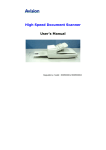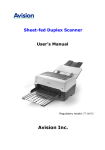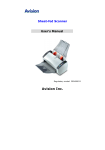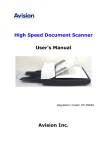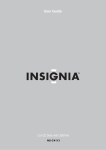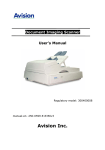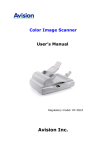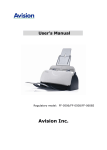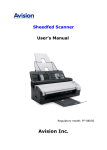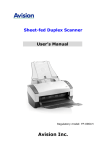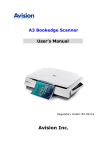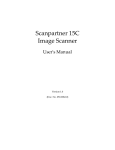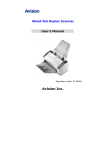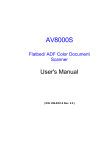Download High Speed Document Scanner User`s Manual
Transcript
High Speed Document Scanner User's Manual Regulatory model: DF-0902H Avision Inc. Trademarks Microsoft is a U.S. registered trademark of Microsoft Corporation. Windows and MS-DOS are trademarks of Microsoft Corporation. IBM, IBM PC are registered trademarks of International Business Machines Corp. ENERGY STAR® is a U.S. registered mark. Other brands and product names herein are trademarks or registered trademarks of their respective holders. Copyright All rights reserved. No part of this publication may be reproduced, transmitted, transcribed, stored in a retrieval system, or translated into any language or computer language, in any form or by any means, electronic, mechanical, magnetic, optical, chemical, manual, or otherwise, without the prior written permission of Avision Inc. Material scanned by this product may be protected by governmental laws and other regulations, such as copyright laws, the customer is solely responsible for complying with all such laws and regulations. Warranty The information contained in this document is subject to change without notice. Avision makes no warranty of any kind with regard to this material, including, but not limited to, the implied warranties of fitness for a particular purpose. Avision shall not be liable for errors contained herein or for incidental or consequential damages in connection with the furnishing, performance, or use of this material. ii User’s Manual Federal Communications Commission (FCC) compliance information statement Part 15 The product has been tested and found to comply with the limits for a Class A digital device pursuant to Part 15 of the FCC Rules. Operation is subject to the following two conditions: (1) this device may not cause harmful interference and (2) this device must accept any interference received including interference that may cause undesired operation. The FCC Class A limits are designed to provide reasonable protection against harmful interference when the equipment is operated in a commercial environment. This equipment generates, uses, and can radiate radio frequency energy and, if not installed and used in accordance with the instruction manual may cause harmful interference in which case the user will be required to correct the interference at his own expense. CE Warning This is a class A product. In a domestic environment this product may cause radio interference in which case the user may be required to take adequate measures. iii Disposal of Waste Equipment This symbol on the product or on its packaging indicates that the product can not be disposed of with your other household waste. Instead it should be sent to appropriate facilities for recovery and recycling in an effort to protect human health and the environment. For more information about where you can drop off your waste equipment for recycling, please contact your local city office, your household waste disposal service or the shop where you purchased the product. As an ENERGY STAR® Partner, Avision Inc. has determined that this product meets the ENERGY STAR guidelines for energy efficiency. System Requirements • IBM compatible PC 586, Pentium or higher • Microsoft Windows 2000/XP • High speed USB 2.0 port (compatible with USB 1.1) • 100M bytes of available hard disk space for installation; • 128M bytes of RAM • A CD-ROM drive iv User’s Manual Table of Contents 1. Introduction.............................................. 1-1 2. Installation ............................................... 2-2 2.1 2.2 2.3 2.4 2.5 2.6 3. Completing Your First Scan ....................... 3-1 3.1 3.2 3.3 4. Unlocking the Shipping switch ...................... 2-2 2.1.1 Unlocking the scanner ...................... 2-3 2.1.2 Locking the Shipping switch............... 2-4 ADF Paper Chute........................................ 2-5 ADF Output Tray ........................................ 2-6 Connecting the Cables ................................ 2-7 2.4.1 Connecting to Power......................... 2-7 Installing the Software ................................ 2-7 Connecting to Computer.............................. 2-8 Document Loading ..................................... 3-1 ADF Scanning ............................................ 3-2 Verifying Your Scanner Installation ............... 3-3 3.3.1 A Glance of the Scanner Properties Dialog Box ...................................... 3-7 Using the Scanner Properties Dialog Box .. 4-1 4.1 4.2 4.3 4.4 Buttons on the Scanner Properties Dialog Box 4-2 The Image Tab .......................................... 4-4 4.2.1 The Image Selection Box................... 4-5 4.2.2 Other Image Options ........................ 4-8 4.2.3 Scanning color images .................... 4-17 4.2.4 Scanning grayscale images.............. 4-18 4.2.5 Scanning B&W images .................... 4-18 4.2.6 Editing Profiles............................... 4-19 The Compression Tab ............................... 4-22 The Color Dropout Tab .............................. 4-24 4.4.1 Color Dropout Selection .................. 4-24 4.4.2 Other Color Dropout Options............ 4-25 v 4.5 4.6 4.7 4.8 4.9 The Paper Tab ......................................... 4-27 4.5.1 Cropping ..................................... 4-28 4.5.2 Other Paper Selection ................. 4-31 4.5.3 Relative to Document .................. 4-37 The Preview Tab ...................................... 4-40 The Options Tab....................................... 4-41 The Setting Tab ....................................... 4-46 The Information Tab ................................. 4-49 5. ISIS Interface Operation........................... 5-1 6. Maintenance.............................................. 6-1 6.1 6.2 6.3 6.4 7. Cleaning the ADF ....................................... 6-1 Cleaning the Glass...................................... 6-3 Replacing the ADF snap-in pad module.......... 6-4 Replacing the ADF Paper Feed Roller ............. 6-6 Trouble shooting ....................................... 7-1 7.1 7.2 Question and Answer .................................. 7-1 Paper Jam in the ADF ................................. 7-5 8. Technical Service ...................................... 8-1 9. Specifications............................................ 9-1 Index .................................................................. a vi User’s Manual 1. Introduction Congratulations on your purchase of the document scanner. Before you install and operate the scanner, please take a few minutes to read through this manual. It provides you with the proper instructions on how to unpack, install, operate and maintain the scanner. Figure 1-1 shows how the scanner is packed. You can check all items against your “checklist”, included with your scanner. 3 4 1 5 1. 2. 3. 4. 5. Scanner main unit Power adapter Power cord USB cable User’s manual/CD Figure 1-1 Scanner Packaging Note: When you unpack the scanner, retain the packing material and shipping box in case you may transport the scanner in the future. 1-1 2. Installation Please unpack the scanner carefully, and check the contents against the checklist. If any items are missing or damaged, please contact your authorized local dealer immediately. Precautions • Keep the scanner out of direct sunlight. Direct exposure to the sun or excessive heat may cause damage to the unit. • Do not install the scanner in a humid or dusty place. • Use only the AC adapter ((HEG42-240200-7L by HITRON / DA-48M24 by ADP)) included with the machine. Using other AC adapters may damage the machine and void the warranty. • Place the scanner securely on an even, flat surface. Tilted or uneven surfaces may cause mechanical or paper-feeding problems. • Retain the scanner box and packing materials for shipping purposes. 2.1 Unlocking the Shipping switch The scanner has a shipping switch that locks the carrier mechanism for transportation purposes. This switch must be unlocked before using the scanner. Before proceeding, turn the power off, disconnect all cables and follow the instructions below to unlock the shipping switch. 2-2 User’s Manual 2.1.1 Unlocking the scanner 1. Carefully place the scanner in an upright position on its front. 2. Unlock the scanner by moving the lock switch beneath the scanner to the “Unlock” position (See Figure 2-1). 3. Gently place the scanner back to its normal position. Figure 2-1 Unlock the Shipping Switch 2-3 2.1.2 Locking the Shipping switch Whenever you need to move the scanner to a new location it is advisable to lock the shipping switch to avoid causing damage to the scanners’ internal mechanism. Please follow the instructions below to lock the shipping switch. 1). Turn off the scanner. 2). Lift the Document cover to reveal the flatbed glass and scanning unit. 3). Turn on the scanner. 4). Turn off the scanner again while the scanning unit moved to the end for a few seconds. 5). Place your scanner in an upright position on its front side. 6). Lock your scanner by moving the lock switch to the "Locked position". 7). Place the scanner back to its normal position. 2-4 User’s Manual 2.2 ADF Paper Chute 1. Lift the paper chute to about 45 degrees. 2. Pull the paper-chute wire leg down to the grips on the document cover. 3. Slightly press the paper chute to snap the wire leg into the grips on the document cover. 4. Pull out the paper chute extension to the length you want. Paper Chute Extension ADF Paper Chute Paper Chute Wire Legs Figure 2-3 Install the ADF Unit 2-5 2.3 ADF Output Tray 1. Hold the output paper tray some 30 degrees aslant as shown in Figure 2-4. 2. Insert the three protrusions on the output paper tray to the three slots on the ADF. 3. Release the paper tray gently. Make sure the tray is firmly attached to the ADF. 4. Pull out the output paper tray extension wire to the desired length. Output Tray Extension Wire Figure 2-4 Install the ADF Output Paper Tray 2-6 User’s Manual 2.4 Connecting the Cables Make sure the power of scanner is off. 2.4.1 Connecting to Power Plug the small end of the power adaptor into the power jack of your scanner. Insert the other end to an appropriate power outlet. Power Cable 2.5 Installing the Software Note: 1). The Windows system CD may be required when installing on some PC’s. 2). To ensure your computer can identify the USB scanner, please install scanner driver first before connecting the scanner to your computer. 1. Place the supplied CD-ROM onto your CD-ROM drive. 2. The software installation graphic appears. If not, run “setup.exe”. 2-7 3. Choose Install Scanner Driver to install the scanner driver. 2.6 Connecting to Computer 1. Connect the square end of the USB cable to the USB port of your scanner. Connect the rectangle end to the USB port of your computer. USB Cable 2-8 User’s Manual 2. The computer should detect a new USB device and prompt a “New Hardware Found” message. 3. In Windows XP, click the Next button to continue. When the XP certification screen appears, click Continue Anyway to complete the installation. 4. When the Finish dialog is prompted, click the Finish button. 5. Click “View Manual” to view or print the detailed user manual for the scanner and bundled applications respectively. Note: To uninstall the scanner driver in Windows XP, be sure to keep your scanner connecting to your computer. 2-9 User’s Manual 3. Completing Your First Scan 3.1 Document Loading For flatbed scanning Documents that can not be scanned using the ADF can be placed on the flatbed for scanning. (See Figure 3-1) 1. Place the document to be scanned onto the document glass face down. 2. Position the document so that the upper-right corner is aligned with the reference mark. Figure 3-1 Place Document on the scanner 3-1 3.2 ADF Scanning Multiple documents can be fed automatically using the ADF. Refer to Figure 3-2. 1. To prevent occasional paper jam when automatically feeding multiple documents, fan the paper before loading. 2. 3. Lift the balance wire. Place the documents onto the ADF paper chute in either paper side (face-down, face-up), with the leading edge in the auto feeder entrance. Let the balance wire rest on the top of the documents. 4. Adjust the left and right guides so that they are snug against the sides of the documents. Balance Wire Paper Guide Figure 3-2 Load Multiple Document 3-2 User’s Manual 3.3 Verifying Your Scanner Installation To verify if your scanner installation is correct, Avision provides you a useful test program called Avision Capture Tool. With this tool, you can perform simple scans and view the captured images. In addition, it helps you complete your scan at a rated speed. The following procedure describes how to verify your scanner installation. If the installation is not correct, please review the preceding section to check if the cable connection and scanner driver have been successfully installed. Before you begin, be sure the scanner is on. 1. Select Start>Programs>Avision AVxxx Scanner>Avision Capture Tool. The Select Scanner Model dialog box will be displayed. 2. Select your driver type and scanner model and click OK. The following Avision Capture Tool dialog box will be displayed. 3-3 Fit Actual Page Size Setup Scan File Format Save File Path 3. Choose your desired file format from the File Format drop down list box. (Default is BMP, other choice includes TIFF, GIF, and JPEG.) 4. Type your desired folder name and file name in the File Path box. (Default is C:\My Scan\Image.) Note: If you do not wish to save the scanned image, deselect the Save button since default is Save Enable. In this case, the thumbnail view will be disabled. And therefore, after viewing all the scanned images, only the last one will remain on the screen. 5. Click the Setup button ( ) or choose Setup from the File menu to prompt the Scanner Properties dialog box. 3-4 User’s Manual Image Selection Box 6. From the Image Selection Box, choose your desired image type for your scanned image. (Default is Front B&W) If you have a duplex scanner, choose Front and Rear to scan both sides of your document. 7. Click OK to quit the Scanner Properties dialog box. (To learn more details about the Scanner Properties dialog box, please see the subsequent chapter, Using the Scanner Properties Dialog Box.) 8. Place your document face down on the document glass or face up in the auto document feeder. 9. In the Scan Validation dialog box, click the Scan button ( ) or choose Scan from the File menu. 10. The document will be scanned and displayed in the Scan Validation screen. After the scanned images have been displayed, your scanner installation verification is completed. 3-5 Status Bar Fit Page View Thumbnail View 11. You can view the scanned image in Fit Page ( Actual Size (100%) button ( at the right side. ) or ) from the Viewing toolbars 12. Click the Close box or Quit from the File menu to exit the Scan Validation Tool. 3-6 User’s Manual 3.3.1 A Glance of the Scanner Properties Dialog Box 1 2 3 4 5 6 7 8 1. Tab Options Choice: Image, Compression, Color Dropout, Paper, Options, Settings, Information. 2. Image Choose your image type and the side of Selection Box document you wish to scan. Options vary based on type of scanner. 3. Brightness: Adjust the brightness level from –100 to +100. 4. Contrast Adjust the contrast level from –100 to +100. Determine the quality of the scanned image. 5. Resolution The industry standard is 200 dpi. 6. Invert Reverse the color of your scanned image. 7. Scan Source Choice: Auto Document Feeder, Flatbed, Flatbed (Book), Automatic (varies due to different scanner model) 8. Defaults Reset all values on the tabs to the factory default settings. 3-7 User’s Manual 4. Using the Scanner Properties Dialog Box The Scanner Properties dialog box allows you to configure the scanner’s settings. It consists of several tabbed windows each of which will be described in this chapter. The Scanner Properties dialog box 4-1 4.1 Buttons on the Scanner Properties Dialog Box The buttons on the Scanner Properties dialog box Buttons Description Defaults Click the Defaults button, the factory default settings will be shown on each tab. Scan After all the scan settings are satisfactory, click the Scan button to start scanning your document. Close Click the Close button to leave the Scanner Properties dialog box. 4-2 User’s Manual The following table shows the default settings: Tab name Image Default settings Image:Front B&W Binarization:Dynamic Threshold Resolution:200 dpi Invert:Blank on White Scan Source:Auto Document Feeder Threshold:None Brightness:None Contrast:None Compression None Color Dropout None Paper Cropping:Automatic Deskew:Yes Orientation:Portrait OverScan:0.00 Multifeed Detection:None Unit:Inch Options Rotation Degrees:None Blank Page Removal:None Edge Fill:White,0 mm Image Control Option:None Setting Enable Energy Saver:Enable, 15 minutes after last scan action Show Scanning Progress:Yes Show Warning Message:Yes Save Settings after Closing:Yes 4-3 4.2 The Image Tab The Image tab allows you to choose the front side and (or) the rear side of your document, the type of image, and to set several basic scan settings. Note that except for the resolution, you can set individual scan settings for the front side and the rear side. For example, all settings in the Image tab, Compression tab, Color Dropout tab can be set individually for the front and the rear side. However, the settings in the Paper tab, the Option tab, and the Setting tab have to be set the same for the front and rear side. The Image tab dialog box 4-4 User’s Manual 4.2.1 The Image Selection Box The Image Selection box includes the image type and document side option. If you wish to scan both the front side and the rear side of your color document, you can check both Front Color and Rear Color at the same time. Note the options vary based on type of scanner. Example 1:Scanning a two-sided color document, both sides in color Side/Image Selection Front 4-5 Rear Example 2:Scanning a two-sided color document, one in B&W(Drop Blue Color:Threshold:10, Background: 79), the other in color Side/Image Selection Image Type Color Gray B&W B&W Front Rear Description Choose Color if you wish to scan a color image for your original in color. Choose Gray image if your original contains actual shades of gray. Choose B&W if your original contains only text pencil or ink sketch. Gray Color 4-6 User’s Manual Front/Rear Auto Color Detection: Click to automatically detect and scan the front or the rear page of your color document in color image mode. If your document is in colors, the scanner will automatically scan the document into a color image. If your document is non-color, you can choose the output to be either B&W or Gray from the Non-Color Selection option. This option is useful when you have a mixture of color and non-color document. Note: If you choose Front Rear Auto Color Detection, you can not specify the image mode of your rear page and vice versas. 4-7 4.2.2 Other Image Options Binarization This is the process of converting a grayscale or color image to a bi-tonal image. There are several different methods of performing this conversion. Options: Dynamic Threshold, Fixed Processing, Halftone 1~5, Error Diffusion. Dynamic Threshold: Selecting Dynamic Threshold allows the scanner to dynamically evaluate each document to determine the optimal threshold value to produce the highest quality image. This is used to scan mixed document containing faint text, shaded background, or color background with a single setting. If Dynamic Threshold is selected, Threshold, Brightness, and Contrast are not available. Fixed Processing: Used for black-andwhite and other high contrast documents. A single level is set to determine the black-and-white transition. The threshold is programmable over the entire density range. Fixed Processing sets Contrast to 0. If Fixed Processing is selected, Contrast is not available. 4-8 User’s Manual Halftone: In addition to the black and white display, Halftone can present a somehow gray shade of image by using different size of dots. Halftone image looks like the picture we have seen in the newspaper. Options include Halftone 1, Halftone 2, Halftone 3, Halftone 4, Halftone 5. Error Diffusion: Error Diffusion is a type of Halftone. Error Diffusion gives good image texture and makes text in images more readable than Halftone. Halftone Image Error Diffusion Image 4-9 Threshold Used to convert a grayscale image to a bi-tonal image. The value ranges from 0 to 255. A low threshold value produces a lighter image, and can be used to subdue backgrounds and subtle, unneeded information. A high threshold value produces a darker image, and can be used to help pick up faint images. Adjust the threshold setting by dragging the Threshold sliding bar to the left or right to achieve the desired threshold setting. 200 dpi, Threshold:80, Brightness: 0 4-10 200 dpi, Threshold:170, Brightness: 0 User’s Manual Gray Document Type: Choice: Normal, Photo, Document Three options of document type are provided when you choose Gray as the image type for your scanned document. Choice: Normal, Photo, Document. • • • Document: Choose Document if your original contains pure text or a mixture of text and graphic since it is an optimal setting for regular business document. When using Document, only Threshold can be adjusted. Photo: Choose Photo if your original contains photo to reproduce your photo in vivid grayscale image. When using Photo, no Threshold and Contrast can be adjusted. Normal: When using Normal, Threshold, Brightness, and Contrast can be adjusted. Threshold: The value ranges from 0 to 255. The default is 230. A low threshold value produces a lighter image, and can be used to subdue backgrounds and subtle, unneeded information. A high threshold value produces a darker image, and can be used to help pick up faint images. Adjust the threshold setting by dragging the Threshold sliding bar to the left or right to achieve the desired threshold setting. 4-11 Normal Photo Document (Threshold: 230) Normal Photo Document (Threshold: 230) 4-12 User’s Manual Brightness Adjusts the lightness or darkness of an image. The higher the value, the brighter the image. Drag the slider to the right or left to increase or decrease the brightness. Contrast Adjusts the range between the darkest and the lightest shades in the image. The higher the contrast, the bigger the different grayscale. Drag the slider to the right or left to increase or decrease the contrast. The range is from –100 to +100. The range is from –100 to +100. Brightness: -50 Brightness: 0 (Normal) Brightness: +50 Contrast: -50 Contrast: 0 (Normal) Contrast: +50 4-13 Resolution A good control of the resolution results a good detail of an image that scans. The resolution is measured by dots per inch (dpi). Normally, the greater the dpi number, the higher the resolution and the image file size. Be aware that greater resolution takes more time to scan, and more disk space for the scanning image. For your information, an A4 size color image scanned at 300 dpi at True Color mode consumes approximately 25 MB of disk space. A higher resolution (usually means over 600 dpi) is only recommended when you need to scan a small area at True Color mode. Choose a resolution value from the drop down list. The default value is 200 dpi. Available resolutions are 75, 100, 150, 200,300, 400 and 600. Or you may choose your desired value by clicking the box in the right side of the drop down list and press the arrow key to select your desired value and then click the Add button to include it in the drop down list. Resolution: 75 dpi Resolution: 150 dpi 4-14 User’s Manual Invert Reverses the brightness and the colors in the image. The default setting is Black on a White background. Reverse mode is White on a Black background. For color images, each pixel will be changed into its complementary color at the command of Invert. Black on White White on Black 4-15 Scan Source Choice: y Auto Document Feeder: Used to scan multiple pages. y Flatbed: Used to scan a single page. For example, pages from newspaper clipping, paper with wrinkles or curls. y Flatbed (book): Used to scan several inside pages from book. y Automatic: Allow the scanner automatically set its scan source. If Automatic is selected and there is document in both the auto document feeder (ADF) and the flatbed, then the scan source will be automatically set to ADF. If Automatic is selected and there is document only in flatbed, then the scan source will be set to flatbed. y Merge Two Sides into One Image: If you have a sheet-fed duplex scanner with front input tray, you can scan an A3 size document with an innovative method. Thus, fold your A3 size document into A4, and then load the paper in the front tray. Choose Merge Two Sides from the Scan Source option and then the scanner is able to scan both sides of your document and merge two A4 images into one A3 image. When you select Merge Two Sides into One Image, the Cropping or Multi-feed function will be disabled. Note the options vary based on type of scanner. 4-16 User’s Manual Color Adjustment Adjusts the color quality of the image so that it comes close to that of the original. This function uses default parameters to adjust the image. Normal After Color Adjustment 4.2.3 Scanning color images The following options are available for scanning color images. y y y y Brightness Contrast Resolution Invert 4-17 4.2.4 Scanning grayscale images The following options are available for scanning gray images. y y y y Brightness Contrast Resolution Invert 4.2.5 Scanning B&W images The following options are available for scanning B&W images. y y y Or y y y y y Binarization (Dynamic Threshold) Resolution Invert Binarization (Fix Processing) Threshold Brightness Resolution Invert 4-18 User’s Manual 4.2.6 Editing Profiles The Scanner Properties dialog box allows you to change and save your frequently used scan settings into a profile. You can edit these profiles by renaming or deleting them. To add a new profile, 1. 2. Customize your settings. (For example, change your resolution, image type, cropping method, scan size, or other scan settings.) Click the Image tab and then choose “Profiles” to prompt the “Edit Your Profile” dialog box. 3. Click “Add” to enter the name of the profile and then choose “Save”. 4. The new profile will be saved and shown in the “Profiles” dropdown list box. 4-19 To load a profile, 1. From the Image tab dialog box, choose your favorable profile from the “Profiles” dropdown list box. 2. Your favorable profile will be immediately loaded and displayed on Scanner Properties dialog box. To delete a profile, 1. From the Image tab dialog box, click “Profiles” to prompt the Edit Your Profile dialog box. 2. Choose the profile you want to delete from the dropdown list box. Click “Delete”. A Confirm message “Are you sure you want to delete this profile?” is prompted. Choose “Yes” to delete or “Cancel” to quit. 3. 4. 4-20 User’s Manual To rename a profile, 1. From the Image tab dialog box, click “Profiles” to prompt the Edit Your Profile dialog box. 2. Choose the profile you want to rename from the dropdown list box and then click the Rename button. 3. Enter new name for the profile. 4. Choose “Save” to save the new profile or “Cancel” to quit. Note: The preset default profiles include Flatbed, Simplex-B&W, 200 dpi, Simplex-Gray, 200 dpi, Simplex-Color, 200 dpi, DuplexB&W, 200 dpi, Duplex-Gray, 200 dpi, Duplex-Color, 200 dpi. If you have a simplex or a sheetfed scanner, the duplex or the flatbed option will not be available. 4-21 4.3 The Compression Tab The Compression tab allows you to compress your scanned image and choose the level of compression. Bi-tonal images are normally compressed using CCITT standard called Group 4 (G4). Color and grayscale images are often compressed using JPEG technology. Move the JPEG Quality slider to the right or left to increase or decrease the level of compression. Note the greater the compression level, the lower image quality. Default is 50%. Note that the compression depends on your image editing application. If your image editing application does not support the type of compression format, then either a warning message will appear or the image quality of the compressed file will not be acceptable. JPEG (Joint Photographic Editor Group). This group developed and lent their name to a file compression standard for color and grayscale images that is widely used by scanners, and software applications. On Microsoft Windows-based systems, a file with the extension .jpg has normally been compressed using this standard. For scanning color or gray images, the following compressions are available: y None y JPEG For scanning B&W images, the following compressions are available: y None y G4 4-22 User’s Manual The Compression tab dialog box 4-23 4.4 The Color Dropout Tab 4.4.1 Color Dropout Selection Color Dropout tab allows you to drop either of the red, blue, or green color in your scanned image. If your image contains red color watermark or background, choose the R (Red) channel then any red watermark or background will be removed. This feature is used to sharpen your text when using OCR (Optical Character Recognition) software. Note that this function supports only black & white and gray images. Therefore, be sure to choose any black & white or gray image type while applying this function. The Color Dropout dialog box 4-24 User’s Manual 4.4.2 Other Color Dropout Options Advanced Processing provides two options that can adjust your scanned image in the best optimal result. Filter Threshold This value is used to determine the color which will be dropped out. A lower value will drop more of the selected color out, while a higher value will leave more of the selected color in. Background Level The pixel which is higher than the background value will be adjusted to the lightest point. Adjust the value for both the Filter Threshold and Background Level to produce the best optimal result. Example, slightly adjusting the background value makes your text more clear. Original 4-25 Remove Blue, Threshold: 20, Background: 255 Remove Blue, Threshold: 20, Background Level: 210 4-26 User’s Manual 4.5 The Paper Tab The Paper tab allows you to define values relating to image output (i.e., Auto Crop or not, Scan Area, OverScan, Multi-Feed Detection). The Paper tab dialog box 4-27 4.5.1 Cropping Cropping allows you to capture a portion of the document being scanned. Choice: Automatic, Fixed to Transport, EOP (End of Page) Detection. Options Description Automatic Automatic adjusts the cropping window according to different document sizes. Use this option for batches of mixed-sized documents. Fixed to Transport This feature allows you to define the area or zone to be imaged. Use for batches of same-sized documents. If you select this option, you can use the arrow keys to define the x and y offset values, width and length to redefine your scanned area. The Display window will show image placement as you change the values. EOP (End of Page) Detection This feature allows you to define the area or zone to be imaged. Use for batches of same-width but different length documents. If you select this option, you can use the arrow keys to define the x and y offset values, width and length to redefine your scanned area. The Display window will show image placement as you change the values. 4-28 User’s Manual The following options are only available when Fixed to Transport is selected. y X-Offset — the distance from the left end of the scanner to the left edge of the scanning area. y Y-Offset — the position from the top end of the document to the top end of the scanning area. y Width — the width of the scanning area. y Length — the length of the scanning area. y Center: automatically calculates the x-offset for centerfed feeding based upon document size selected. y — relocate the scan area by click the arrow key on the cross sign while retain the scan size. View the result from the Display window. 4-29 Example: Redefine your scan area ( x-offset: 2.25 inches;yoffset:1.13 inches) Scan Area Display window After Fixed to Transport Original The Redefined Scan Area 4-30 User’s Manual 4.5.2 Other Paper Selection Deskew Use this option to automatically deskew a document. Note: If the skew angle is too great, some of the image may be cut off. Scan Area Choose your desired paper size with the drop-down list box. Or you may select a custom paper size by clicking the Scan Area box and then click Add to include in the choice. Choice: None, US Letter- 8.5”x 11”, US Legal – 8.5” x 14”, ISO A4 – 21 x 29.7 cm, ISO A5 – 14.8 x 21 cm, ISO A6 – 10.5 x 14.8cm, ISO A7 – 7.4 x 10/5 cm, ISO B5 – 17.6 x 25 cm, ISO B6 – 12.5 x 17.6 cm, ISO B7 – 8.8 x 12.5 cm, JIS B5 – 18.2 x 25.7 cm, JIS B6 – 12.8 x 18.2 cm, JIS B7 – 9.1 x 12.8 cm, Scanner Maximum, Long Page. Long Page: When you need to scan documents whose length exceeds scanner maximum, please choose Long Page. Note if Long Page is selected, the Multi-Feed Detection will not be available. Options: Unknown Length, Enter Length (Note: This option varies due to type of scanner.) 4-31 Choose “Unknown Length” if you have a batch of long page document with unknown length. Choose “Enter Length” to enter the length and width of your documents or your desired scan size on documents. This is useful when you have a batch of documents with the same scan size or a batch of same-sized documents. OverScan Overscan allows you to add a specific margin at top and bottom or right and left (Options vary based on the type of scanner) of the edge of the image. This is used to reduce possible corner clipping on the skewed images and often applied to a batch of skewed document to be scanned in the auto document feeder. Select a value between 0 and +5 mm. Note the overscan result will not be shown in the Display window and that the availability of the function varies based on type of scanner. Multi-Feed Detection Multi-Feed Detection allows you to detect overlapped document that go through the auto document feeder. Multi-Feed usually occurs due to stapled documents, adhesives on documents, or electro-statically charged document. Note: The availability of the function varies based on type of scanner. Additional Length Detection Additional Length Detection allows you to define the length of document being multi-fed. This value indicates the additional length exceeding your scan area. The Display window will show the size of the document as you change the value. A value of 0 indicates no additional length detection. The Additional Length Detection is best used when scanning samesize documents in the auto document feeder. 4-32 User’s Manual Example:Additional Length Detection:Set Additional Length to be 2.02 inches 2.02” 4-33 Ultrasonic Detection Ultrasonic Detection allows you to set overlapped document by detecting paper thickness between documents. Note: The availability of the function varies based on type of scanner. There are two options available if Multi-Feed is detected. z Stop Scanning after Multi-Feed If this is selected, the scanner will stop the feeder and display the following Warning dialog box if multi-feed is detected. Action: 1. Follow the instruction on the Warning dialog box to remove the rest pages on the feeder. 2. Click OK to close the Warning dialog box. 3. Scan the rest pages. 4-34 User’s Manual Clear the Multi-Fed Paper: Choice: Manual, Auto If Auto is selected, once multi-feed is detected and scanning operation is stopped, the scanner will automatically clear the transport of the multi-fed paper. If manual is selected, once multi-feed is detected and scanning operation is stopped, you need to manually clear the transport of the multi-fed paper. Note: The availability of this option varies based on type of scanner. 4-35 z Multi-Feed Alarm If a wave file is added, the scanner will make a sound alarm if multi-feed is detected yet no Warning dialog box will be displayed. If “Stop Scanning after Multi-Feed” is selected, the scanner will stop the feeder. If “Stop Scanning after Multi-Feed” has not been selected, the scanner will continue to scan till the end of your document. Action: 1. If “Stop Scanning after Multi-Feed” is selected, follow the action described in the preceding section “Stop Scanning after Multi-Feed” on the previous page to complete your job. 2. If “Stop Scanning after Multi-Feed” has not been selected, rescan the pages where multi-feed is detected. How to add the sound alarm: 1. Click the Browse button on the right side of the speaker icon. The Open dialog box appears. 2. Choose your wave file. 3. Click the Open button. The wave file is added. Units Defines the primary measurement system. Inches, Millimeters, and Pixels are available. 4-36 User’s Manual 4.5.3 Relative to Document Relative to Document: (used for batches of same-sized documents) This option allows you to crop different areas on your documents and deliver these images in B&W, Gray, or Color separately. For example, there are applications which require you to store the entire document in B&W and a part of the document in color to save storage space. This is useful for documents where a photograph, or signature appears in a consistent area on the document such as resumes, and so on. The following procedure describes how to reproduce the entire document in B&W and a portion of document (picture) in color. 1. On the Paper tab, choose “Relative to Document” or “Fixed to Transport” from the Cropping option. 2. Choose your scan size from the Scan Area option. The selected scan size will be displayed in a red rectangular box. This is also the scan size of your entire document. (For example, ISO B5. If you have not chosen a scan area and leave the selection as None, then the default area will be the scanner’s maximum.) 1 A red rectangular box 2 4-37 3. Click the Preview tab to display the Preview window. A black rectangular box appears to indicate the max. scan size your have just selected. The Image Selection Box The selected image A black rectangular box 4. Click the Preview button to view the entire image in low resolution to correctly crop your relative scan area. The Preview Image The Preview Button 5. Select image type from the Image Selection box. The selected image will appear in highlighted color. (For example, Front Color) 6. Place your cursor on the Preview window and click your left mouse button. A cross sign will appear as illustrated. Create your relative scan size diagonally by dragging the left mouse button to your preferable size. The selected area will appear in a red box as illustrated. 4-38 User’s Manual A Cross Sign 7. 8. The Relative Area Check the B&W image from the Image Selection box to scan the entire document. Click the Scan button to start scanning the document in two image types and sizes. (See the result in below.) The entire document in B&W 4-39 The relative area in color 4.6 The Preview Tab The Preview tab allows you to preview (a low-resolution scan) your image before final scan. This preview image lets you allocate your scan area. You can choose your scan area by the “Scan Area” drop down list box or placing your cursor on the Display window and dragging it diagonally on the Display window. Then, a red rectangle box will appear to indicate the selected area. Note: If you choose “Automatic Cropping” on the “Paper Tab”, then to select a scan area on the Preview tab is not allowed. The Display Window The Preview Tab 4-40 User’s Manual 4.7 The Options Tab The Options tab allows you to set following additional image processing settings. The Option tab dialog box 4-41 Flip Side Rotation Select “fanfold” to rotate the image of the reverse side to 180 degrees. This is applied to double-sided document which are viewed in portrait are sometime fed into the scanner in landscape or vice versa. Choice: Book, Fanfold. If “Book” is selected, the image of the reverse side will not be rotated. The following illustration shows the documents which should be viewed in portrait are fed into the scanner in landscape 4-42 User’s Manual Rotate Image Choose the rotation angle from the drop down list if you wish to rotate your scanned image. Choice: None, 90°CW(clockwise), 90°CCW(counter clockwise), 180°. Original Rotate 90°CCW Blank Page Removal Rotate 90°CW Rotate 180° Check if you wish to remove the blank page and move the slider to the left or right to your desired threshold. 4-43 Edge Fill Check White or Black if you wish to add white or black edge on the border of your scanned image. Enter the value from 0 to 5 mm. Default value is 0. Original Image Control Option Edge Fill: 5mm (Black) Check the Mirror box if you wish to reverse the right and left side of your image. Original The Mirror Effect 4-44 User’s Manual Background Setting This option allows you to set your scan background. Choice: White Background, Black Background. *This option varies based on type of scanner and is available for the front page in the ADF (auto document feeder) only. For the rear page, only the white background is available. White Background Black Background 4-45 4.8 The Setting Tab The Setting tab allows you to set the following settings: The Setting tab dialog box Energy Saving Control Check the Enable Energy Saver box and move the slider to the right to set the amount of time to start the energy saver after your last action. The range is from 1 to 240 minutes. The default is 15 minutes. 4-46 User’s Manual Batch Scan Setting •Batch Scan To increase the scanning speed, the scanner first scans a few pages of your document and then sends these scanning data to the application. Therefore, during scanning, the numbers of pages been scanned on the scanner is somehow different with the numbers of pages displayed on your computer screen. Choose this mode if you wish to complete your scanning task at the fastest speed. •Page Scan If you choose Page Scan, during scanning, the scanner will first scan only one page of your document and then send the scanned data to the application and then scan the next page and send the next data to the application, and so on. Therefore, in this mode, the scanning speed is slower yet this helps to keep the same scanning progress between the scanner and your computer screen. Barcode Detection Check this option to enable detecting and recognizing barcode in your document. After the detecting process, an avbarcode.ini file will be generated and stored in your system drive, for example, Windows\avbarcode.ini. Note: The availability of this feature varies based on type of scanner. 4-47 Show Scanning Progress Check and the scanning progress bar will be shown during scanning. Show Warning Message Check to show the warning messages such as “ADF pad count exceeds 50,000 scans (the number varies based on type of scanner). Please replace the ADF pad and reset the pad count.” Save Settings after Closing Check to save your scanner properties settings after leaving the dialog box. Next time when you open the Scanner Properties dialog box, the previously saved settings will be shown. 4-48 User’s Manual 4.9 The Information Tab The Information tab displays the following system and scanner information. The Information tab dialog box The “Report” button: If you encounter any error message while using the scanner, click the Report button. A report.txt file (C:\AVxxx) will be generated. Please send this file to the nearest service center for trouble shooting. 4-49 The “Reset Pad Count” button」: After scanning approximately 50,000 pages (the number varies based on type of scanner) through the Auto Document Feeder (ADF), the ADF pad may be worn out and you may experience problems with document feeding. In this case, it is highly recommended to replace the ADF pad with a new one. (Please refer to the manual for proper replacing procedure.) For ordering the ADF pad, please consult your nearest dealer. After replacing the ADF pad, click the “Reset Pad Count” button to reset the pad count. The “Reset Roller Count” button」: After scanning approximately 200,000 pages (the number varies based on type of scanner) through the ADF, the ADF roller may be worn out and you may experience problems with document feeding. In this case, it is highly recommended to replace the ADF roller with a new one. (Note the replacement of the ADF roller has to be performed only by authorized service center. Therefore, please return your scanner for roller replacement.) After replacing the ADF roller, click the “Reset Roller Count” button to reset the roller count. Note: The lifetime and the replacing procedure vary based on type of scanner. Please consult your nearest dealer for more details. 4-50 User’s Manual 5. ISIS Interface Operation The ISIS driver operation method is similar to the TWAIN’s. Every function on the ISIS interface screen is briefly described as below: Mode: Select one of scan modes, including B&W, gray, color options. Dither: 5 halftone levels available, can be disabled. Dots per inch: Select your desired resolution. Paper Size: Select your desired paper size. Brightness: Adjust your scan image brightness or darkness. Contrast: Adjust the range between the darkest and the lightest shades in the image. Default: Click to reset all settings. Area: Select your desired scan area or position. 5-1 User’s Manual 6. Maintenance 6.1 Cleaning the ADF The scanner is designed to be maintenance free. However, it still needs to be cleaned occasionally to ensure optimum image quality and performance. From time to time the pad assembly and feeding rollers may become contaminated with ink, toner particles or paper dust. In this case the scanner may not feed documents smoothly or several documents may feed at once. If this occurs please follow the cleaning procedures to return your scanner to its original state. The cleaning procedures 1. Moisten a cotton swab with isoprophyl alcohol (95%). 2. Carefully open the ADF to the left. Wipe the feeding rollers by moving the swab from side to side. Rotate the rollers forward with your finger and repeat the above cleaning procedures until the rollers are clean. Be careful not to snag or damage the pick springs. 3. Wipe the pad in the direction from top to bottom. Be careful not to hook the pick springs. 4. Close the ADF unit. Your scanner is now ready for use. 6-1 User’s Manual 6.2 Cleaning the Glass The procedures: 1. Soak a cotton swab with some isoprophy alcohol (95%). 2. Open the ADF unit and document cover as shown in Figure 6-2. Wipe the glass of flatbed area and ADF area by moving the swab from side to side. 3. Close the ADF unit and document cover. Your scanner is now ready for use. Glass Figure 6-2 The Cleaning Area 6-3 6.3 Replacing the ADF snap-in pad module After scanning approximately 20,000 pages through the ADF, the separation pad may be worn out and you may experience problems with document feeding. In this case, it is highly recommended to replace the pad module with a new one. For ordering the pad module, please consult your nearest dealer and follow the procedure below to replace it. Disassembling Procedure 1. Open the ADF cover. 2. Remove the ADF snap-in pad module by pulling out the upper part of the pad clamp as shown in Figure 63. ADF Pad Figure 6-3 Remove the ADF Pad 6-4 User’s Manual Assembling Procedure 1. Take out the ADF pad module from the box. 2. Hold the upper part of the pad clamp and place it gently to the pad holder as shown in Figure 6-4. ADF Pad Figure 6-4 Install the ADF Pad 6-5 6.4 Replacing the ADF Paper Feed Roller 1. Open the ADF cover. ADF cover 2. Lift the tabs. Tab 6-6 User’s Manual 3. Remove the paper feed roller cover. ADF roller cover 4. Remove the paper feed roller. ADF paper feed roller 6-7 5. Insert the new paper feed roller by aligning the tabs into the slots and pressing the roller into place. Slot 6. Reinsert the paper feed roller cover and snap it into place. 7. Close the ADF cover. 6-8 User’s Manual 7. Trouble shooting The scanner will automatically perform a simple self-test each time it is turned on. This will help spot major system errors in the scanner itself. When the test is initiated, the READY LED is flashing. When the test is completed, if no error occurs, the READY LED is steadily on. If you have problems with the operation of your scanner, please check the following troubleshooting hints. 7.1 Question and Answer Question: The LED indicates that the scanner is ready, but the scanner does not respond to the scan command from the host computer. Answer: a) Please check if the signal cable is firmly seated, and invoke the scan command again. If there is still no response, please reset the scanner by turning it off and then on again, and reboot your host computer as well. b) Check if the driver is correctly installed. 7-1 Question: Paper becomes jammed during scanning. Answer: a) Open the ADF unit. b) Pull out the jammed paper carefully. c) Close the ADF unit. Question: More than one sheet of paper were fed into the scanner. Answer: a) Open ADF unit. b) Remove the multi-fed sheets of paper. c) Close the ADF unit. d) Flatten the corners and edges; loosen the paper before reloading it in the paper guide. e) Check the feeding roller condition and do the cleaning if necessary. Question: Paper becomes skewed in the scanner. Answer: a) Check the feeding roller condition; do the cleaning if necessary. b) Use the paper guide when feeding the paper. 7-2 User’s Manual Question: When I power on the scanner, it makes noises and will not stand ready. Answer: There are two possibilities: a) You forgot to remove the shipping switch from the scanner. Please remove the shipping retainer first. b) You did not place the scanner on a flat desktop surface. This may cause the scanner to function improperly. Question: When I power on the scanner, the lamp does not light. Answer: The possibilities are as follows: a) The lamp is out of order. In that case, contact your authorized local dealer to change the lamp. The life time of the lamp is about 5000 hours. b) Check whether the power LED on ADF cover steadily lights or not. If it flashes, the power adapter malfunctions or the main board is short-circuited. Contact your authorized local dealer to replace the power adapter or main board. 7-3 Question: The scanned image always comes out to be too dark. Answer: a) Use your application to modify the Gamma setting to 2.2 and 1.8 for your printer and monitor respectively. b) Use Brightness setting from the TWAIN user interface to get a brighter image. Question: The scanner works well otherwise, but for the line art, the lines scanned seem much thicker than those of the original. Answer: Use the Brightness or Threshold setting to adjust the line art image. 7-4 User’s Manual 7.2 Paper Jam in the ADF In the event of paper jam, please follow the procedures below. i). Open the ADF cover as shown in Figure 7-1. ii). Pull the paper out of the ADF unit carefully. ADF Unit Document Figure 7-1 ADF Paper Jam - Removing the Paper 7-5 User’s Manual 8. Technical Service Technical support for Avision scanner is provided at Avision Technical Assistance Center (ATAC). Before contact with ATAC, please prepare the following information. • • • • Scanner serial & revision number (located on the bottom of the scanner) Hardware configuration (e.g., your host CPU type, RAM size, free disk space, display card, interface card, etc.) The name and version of your software application The version of your scanner driver. Please call us at: US and Canada Area: Address: Telephone: Fax number: Web Site: E-mail: Other Area: Avision Labs., Inc. 6815 Mowry Ave. Newark CA 94560, USA +1 (510) 739-2369 +1 (510) 739-6060 http://www.avision.com [email protected] Avision Inc. Address: No.20, Creation Road I, Hsinchu Science Park, Taiwan, R.O.C. Telephone: +886 (3) 578-2388 Fax number: +886 (3) 577-7017 Web Site: http://www.avision.com Email: [email protected] 8-1 User’s Manual 9. Specifications Model Number DF-0902H Scanning Mode B&W Gray Color Optical Resolution 600 x 600 dpi Light Source Cold Cathode fluorescent lamp ADF Capacity 50 sheets Scan Area Flatbed: up to European A4 (8.5” x 11.69”) ADF: 3.7” x 5.5”(Min) ADF: 8.5” x 14”(Max) Interface USB 2.0 Power Requirement 24Vdc, 2.0A Power Consumption < 48 watts (operation) Operation Temperature 10°C to 35°C Dimension 567 x 350 x 199 mm Weight 7.2 kg (15.87 lbs) < 7 watts (power saving) 9-1 User’s Manual Index A D Additional Length Detection, 4- default settings, 4-3 Deskew, 4-28 document cover, 2-5 Document Loading, 3-1 29 ADF cover, 7-5 ADF Scanning, 3-2 B E B&W, 4-6 Background Level, 4-22 Background Setting, 4-42 balance wire, 3-2 Barcode, 4-44 Binarization Dynamic Threshold, Fixed Processing, 4-8 Blank Page Removal, 4-40 Brightness, 4-10 Edge Fill, 4-41 Energy Saving, 4-43 F Filter Threshold, 4-22 Flip Side Rotation, 4-39 G G4, 4-19 Gray, 4-6 C Cleaning the Glass, 6-3 Color, 4-6 Color Dropout Remove Red, Remove Green, Remove Blue, 4-21 Color Match, 4-14 Contrast, 4-10 Cropping Automatic, Fix to Transport, EOP Detection, 4-25 I Invert, 4-12 J JPEG, 4-19 M Mirror, 4-41 Multi-Feed Detection, 4-29 a Reset Pad Count, 4-47 Reset Roller Count, 4-47 Resolution, 4-11 Rotate Image, 4-40 O output paper tray, 2-6 output paper tray extension, 26 OverScan, 4-29 S Scan Area, 4-28 P paper jam, 3-2, 7-5 protrusions, 2-6 U Ultrasonic Detection, 4-31 R reference mark, 3-1 refit the shipping bracket, 2-4 b


























































































